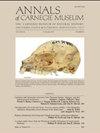宾夕法尼亚州珍稀濒危水牛城坚果的遗传变异及其保护意义发育期螺旋藻
IF 0.9
4区 地球科学
Q4 PALEONTOLOGY
引用次数: 0
摘要
水牛坚果(塞万提斯科);是一种独特的兼性半寄生种,可以无性繁殖或有性繁殖。美国宾夕法尼亚州布法罗坚果的破碎种群代表了该物种最北部的分布范围。随着气候变化将该物种的原生范围进一步向北移动,这些前沿种群可能是新林分的始作俑者。当观察一个孤立的水牛核桃林时,不可能确定单个树是同一亲本植物的克隆还是有性繁殖的产物。本研究首次尝试使用群体遗传学方法来确定破碎林分中单个植物的遗传亲缘关系,并评估北美本土水牛坚果群体的遗传多样性。我们的研究使用微卫星标记比较了宾夕法尼亚州种群样本与其范围北端(即西弗吉尼亚州、肯塔基州和弗吉尼亚州)其他种群样本的遗传变异。我们发现1)在大多数地点无法找到树木,2)宾夕法尼亚州的种群基本上是无性繁殖的,相对于肯塔基州和弗吉尼亚州的种群,在该州(~ 200 km2)的不同地点之间几乎没有遗传多样性。我们提供了保护该物种的最佳实践建议。本文章由计算机程序翻译,如有差异,请以英文原文为准。
Genetic Variation and Conservation Implications in Pennsylvania for the Rare and Imperiled Buffalo Nut (Cervantesiaceae; Pyrularia pubera Michaux)
ABSTRACT Buffalo nut (Cervantesiaceae; Pyrularia pubera Michx.) is a unique facultative hemiparasitic species that can reproduce clonally or sexually. Fragmented population stands of buffalo nut in Pennsylvania, USA, represent the northern–most range of distribution of the species. These leading–edge populations could be the originators for new stands expected to arise as climate change shifts this species' native range further north. When observing an isolated stand of buffalo nut, it is impossible to be sure if individual trees are clones of a common parental plant or the product of sexual reproduction. Our study represents the first attempt to use population genetic methodologies to determine the genetic relatedness of individual plants in fragmented stands, and to assess the genetic diversity of native buffalo nut populations in North America. Our study used microsatellite markers to compare genetic variation in samples from populations in Pennsylvania to samples collected in other populations in the northern end of its range (i.e., West Virginia, Kentucky, and Virginia). We found 1) that trees could not be located at most sites, and 2) that Pennsylvania populations are largely clonal with little genetic diversity among locations within the state (∼200 km2) relative to populations sampled in Kentucky and Virginia. We provide best practice suggestions for conservation of this species.
求助全文
通过发布文献求助,成功后即可免费获取论文全文。
去求助
来源期刊

Annals of Carnegie Museum
综合性期刊-动物学
CiteScore
2.50
自引率
18.20%
发文量
4
审稿时长
>12 weeks
期刊介绍:
Annals of Carnegie Museum is a quarterly journal that publishes peer-reviewed short and medium-length original scientific contributions in organismal biology, earth sciences, and anthropology, in 40 by 52.5 pica format (168 by 220 mm or 6-5/8 by 8-5/8 inches). Subject matter must be relevant to Carnegie Museum of Natural History scientific sections or Powdermill Nature Reserve (PNR), preferably with connection to the Carnegie collection and/or personnel. Carnegie Museum staff and research associates receive publication priority, but others are encouraged to submit papers, especially those manuscripts explicitly based on the Carnegie collection.
 求助内容:
求助内容: 应助结果提醒方式:
应助结果提醒方式:


